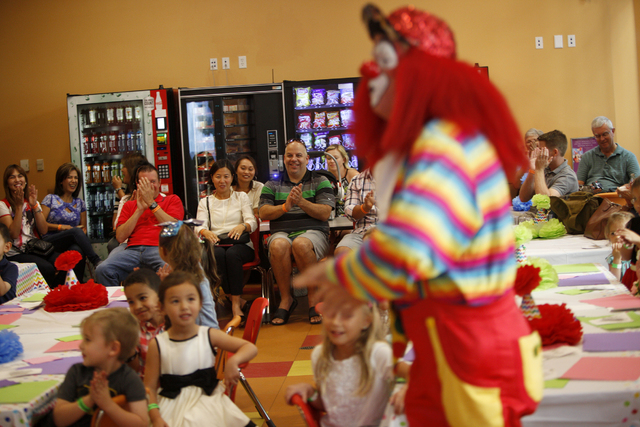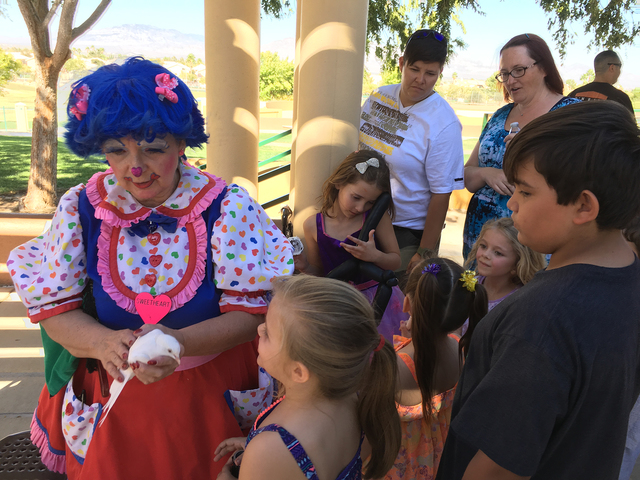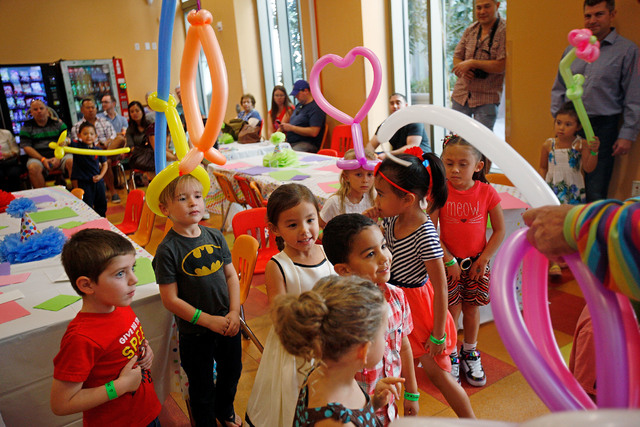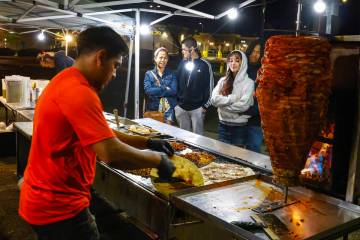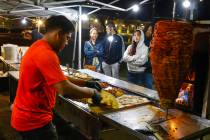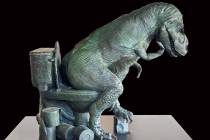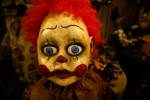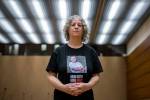‘Creepy clown’ sensation saddens real clowns who only want to bring joy
Charlie Stron ambles into a party room at the Discovery Children’s Museum, which isn’t easy to do when you’re wearing stilts that put the top of your bewigged head way beyond the door frame.
But Stron — who’s known professionally as Charlie the Clown — successfully tips himself into the room where about two dozen kids wait to celebrate Olivia Cooney’s fifth birthday.
For the next hour, Stron juggles rings and balls and clubs, jokes with the kids and even pulls up a few adults to participate in goofy bits. He inflates balloons, twisting them into everything from swords to laser guns to a fishing pole with a fish at the end, and the kids are delighted.
A few hours later and a few miles away, Cindy Mallette arrives at a birthday party at The Hills Park. She, like Stron, arrives in full clown regalia, hers heavy on a heart motif. The kids love her, too, and the only anxiety in the air is about whether Mallette might run out of balloons before the kids can score a second balloon animal from her.
But the happy-go-lucky demeanor and smiling faces that Stron and Mallette bring to their parties hide a sad truth: These are bad times for good clowns.
FALL GUYS
During the past several weeks, newspapers, TV shows and social media have been awash in images of creepy, scary clowns designed to frighten. Schools across the country and here in Las Vegas have prohibited kids from wearing clown costumes at Halloween parties. Clark County School District police even felt compelled to hold a press conference to address alleged clown-related incidents.
Meanwhile, Target has stopped selling Halloween clown masks, and McDonald’s has sent its own signature clown, Ronald McDonald, on vacation.
This spate of scary clowns even has prompted clown harassment. Stron, a professionally trained clown with more than two decades’ experience under his belt, says he has received about 200 prankish, even threatening, phone calls during the past several weeks, while Mallette recently turned down a gig in downtown Las Vegas because she didn’t feel comfortable walking a few blocks in public wearing her clown attire.
James Cooney says that, crazed clown sightings notwithstanding, he and his wife, Michelle, had no qualms about hiring Stron for Olivia’s party. Cooney says he knew of Stron’s work, and knew that Stron “wasn’t one of the creepy clowns.”
Is Olivia a fan of clowns? “As much as any 5-year-old, yes,” he says.
Stron says his resume includes teaching at Ringling Bros. and Barnum & Bailey Circus’ clown college and performing at Disneyland and, in Las Vegas, Circus Circus and the old MGM theme park. While his bookings haven’t been affected by the scary clown craze, Stron says the crank calls he receives are “very tiring and annoying, to say the least.”
Most of the calls seem to come from kids, he says, and often come in the morning, presumably from people back East who find his bio on the internet.
Stron considers himself a professional, a friendly clown with a good heart who only wants to make people laugh. “It’s very odd to be under this kind of attack,” he says.
Mallette started her entertainment career as a magician and eventually segued into clowning at kids’ birthday parties. She figures some of her customers “want a girl clown who, maybe, isn’t as scary as a boy clown.”
But, during the past month or two, “I have not seen as many people requesting clowns,” she says. And, some of the bids submitted to her for potential gigs are turning out to be bogus.
FLIP SIDE
While clowns long have been the personification of goofy joy, they also possess the amazing parallel ability to serve as effective fomenters of fear. Las Vegas public relations executive Mandi McCary has represented Fright Dome at Circus Circus for about six years, and says that, at the beginning, she asked Fright Dome creator Jason Egan for a clown-related favor.
“I made him put in writing in an email he’d keep them at least 10 feet away from me all the time,” McCary says. “I’m fine with zombies and things like that, but clowns, for some reason, totally creeped me out.”
Egan has had clowns at Fright Dome since the attraction opened. A fear of clowns is “just one of those staple fears,” he explains. “It’s like being afraid of snakes. It’s just cultural, with the movies and everything that has come out over the years.”
Warren Ross played “Scorch the Clown” in Freakling Bros. haunted houses here for about 10 years. He counts as key contributors to the modern-day scary clown mosaic that infamous photo of serial killer John Wayne Gacy in clown garb, Tim Curry’s performance as an evil clown in the TV miniseries “It,” the clown doll seen in “Poltergeist” and, more recently, Twisty the Clown in the TV series “American Horror Story.”
“You can never trust a clown, because something just isn’t right about them,” Ross says. “Have you ever been to the circus, and you see clowns sneak up behind people and mimic them? It’s funny to everybody else but, to that person, the clown behind them is terrifying.”
JT Mollner, vice president of Freaklng Bros., which operates three haunted houses in Southern Nevada, says that, among his guests, clowns consistently are cited as “the No. 1 phobia.”
“For me, I think there’s something inherently frightening about permanent happiness kind of painted on someone’s face,” Mollner says. “That’s what’s scary about clowns to me: There’s no way that somebody can be smiling all the time.”
Mollner says we also tend to be discomfited by someone who wears a mask, be it a movie serial killer’s hockey mask or a clown’s exaggerated face paint. “You don’t know what the (real) face is thinking or doing,” he says.
SOCIAL MEDIA CRAZE
“I’m really not a clown person,” says Felicia Campbell, a UNLV English professor and executive director of the Far West Popular Culture Association. “I just always found them hideous and scary. Somebody gave me a clown doll once when I was a child. I couldn’t wait to get rid of it.”
Campbell suspects that clowns — already potentially creepy for their exaggerated, painted-on features, fright wigs and outlandish costumes— become even scarier when we see them out of context, as is depicted in social media-distributed photos of clowns standing at the edge of a wooded area or on suburban streets.
“It’s different when you’ve got 13 of them getting out of a Volkswagen or something,” she says. “It’s when they’re out of context. That’s a different thing.”
Campbell suspects that internet and social media sites — which push creepy clown photos into news feeds at the speed of a soda jet from a clown’s seltzer bottle — have played a significant role in creating America’s current clown frenzy.
“I think it has to be Facebook,” she says. “Everything is instantly on social media now. Things go viral just instantly.”
Brooke Binkowski, managing editor of the Snopes urban legends website (www.snopes.com), traces some of the current clown-based social media posts to “viral advertising for something or other.” (One of the season’s first creepy clown images, which began appearing in August, has been attributed to viral marketing for a movie.)
Binkowski says she began hearing about scary clown sightings about two months ago, “but it did not become full-blown crazy until a couple of weeks ago.”
It’s always tricky to parse out, particularly early in the life of a trend, what it all might mean. Binkowski, for example, can offer an admittedly mushy but intriguing tying of scary clown sightings to the current U.S. presidential campaign.
But it’s also possible that, with Halloween coming, scary clowns just happen to be America’s preoccupation du jour, just as shark attacks were a few summers ago. Such spates of intense media attention “happen when people get wound up one way or another,” Binkowski says.
“It comes in waves,” Egan agrees. “Just like there was a paranormal wave. I definitely think things come in waves, and this year is the wave of the clown.”
Read more from John Przybys at reviewjournal.com. Contact him at jprzybys@reviewjournal.com and follow @JJPrzybys on Twitter.






